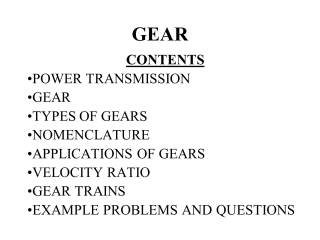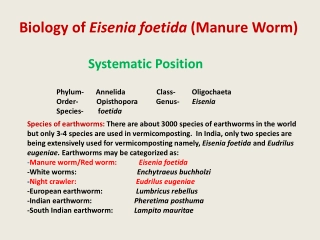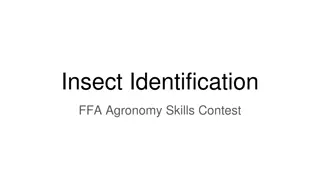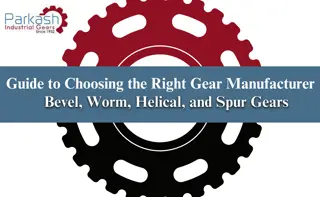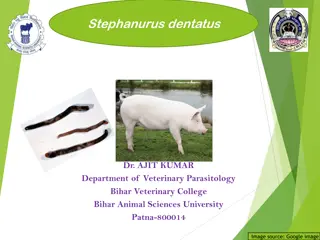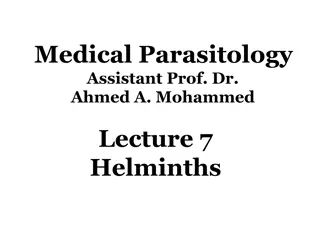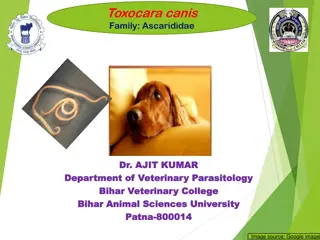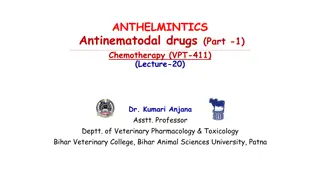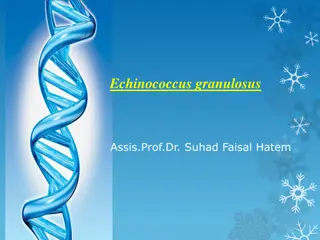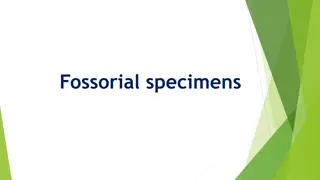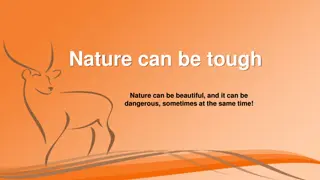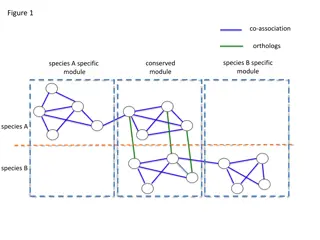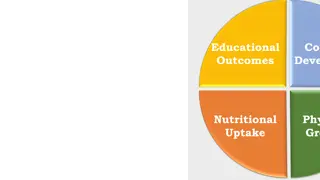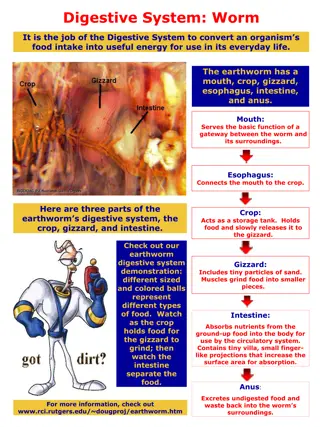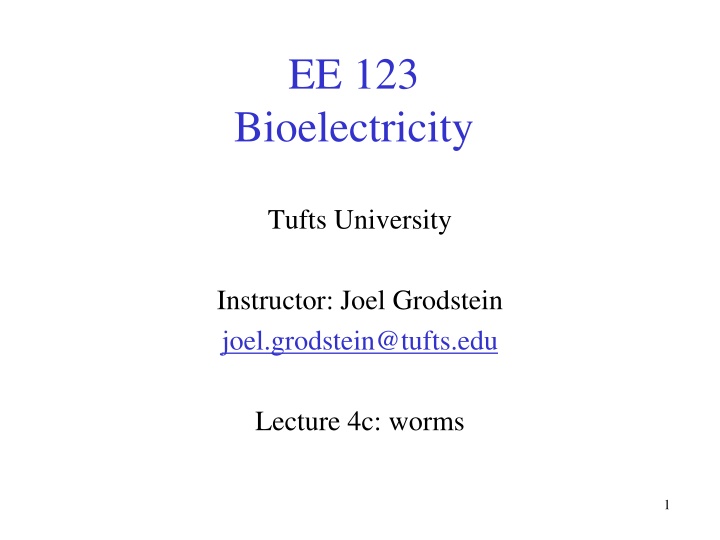
Bioelectricity in Worms: Insights from EE 123 Course at Tufts University
Explore the fascinating world of bioelectricity in worms through the lectures of Joel Grodstein at Tufts University. Delve into topics like morphogenesis, Vmem patterns, GJs, Na+IC, and more, to understand the intricate workings of these creatures at a cellular level.
Download Presentation

Please find below an Image/Link to download the presentation.
The content on the website is provided AS IS for your information and personal use only. It may not be sold, licensed, or shared on other websites without obtaining consent from the author. If you encounter any issues during the download, it is possible that the publisher has removed the file from their server.
You are allowed to download the files provided on this website for personal or commercial use, subject to the condition that they are used lawfully. All files are the property of their respective owners.
The content on the website is provided AS IS for your information and personal use only. It may not be sold, licensed, or shared on other websites without obtaining consent from the author.
E N D
Presentation Transcript
EE 123 Bioelectricity Tufts University Instructor: Joel Grodstein joel.grodstein@tufts.edu Lecture 4c: worms 1
Big picture of the course Where does bioelectricity come from? Neurons and working with the nervous system Cardiac bioelectricity Worms Bio backgrounder Morphogenesis Building a worm Vmem pattern EE 123 Joel Grodstein 2
Review Remember the morphogenesis problem? 37 trillion cells, same software but some are eyes, ears, toes, Our hypothesis: a Vmem pattern is the API that decides which cells become what A machine compares current shape vs. the goal & decides what to do EE 123 Joel Grodstein 3
Using the Vmem pattern 0 .2 Per-cell software: if (0 Vmem .2): Human embryo, 9-10 weeks I_am_head=True if (.4 Vmem .6): I_am_chest=True .5 .7 1 Some cells set I_am_head=True (whatever that means) That triggers their DNA if-then code to build head proteins Objection: something needs to deal with 3D Could do per-region subdivision Next up how can we build this Vmem pattern? 4 EE 123 Joel Grodstein
Contents for this unit Patterning a 5-cell worm our first try Morphagens + lots of feedback our second try GJ connectivity range archipelagos, 2 heads and collapse Wrapup EE 123 Joel Grodstein 5
Vmem + GJs Na+ IC -65mV +25mV IC Start with 5 cells Two end cells have ion channels; set them to -65mV, +25mV Connect them with GJs If we model GJs as resistors, what voltage pattern results? Is that a valid model? What happens with drift and diffusion? Will drift and diffusion balance in each GJ? If so, there s no net current so how (by Ohm s Law) can there be voltage drops? EE 123 Joel Grodstein 6
Vmem + GJs -40mV -20mV 0mV -65mV +25mV IC IC Model GJs as resistors Simple electrical intuition: we get a voltage divider Is that the correct model? No: resistors model drift current, but there s definitely diffusion too Conclusion that intermediate nodes = intermediate Vmem is still valid If GJ drift = -diffusion no net GJ current but drift current > 0 implies V>0 Ohm s Law is only for drift current! EE 123 Joel Grodstein 7
Vmem + GJs -40mV -20mV 0mV K+ Cl- Na+ IC -65mV -60mV +25mV +20mV IC Connect them with GJs What happens? Current flows With most positive ions on the left, diffusion nudges them back The ends dip a bit EE 123 Joel Grodstein 8
Why do the ends dip? ICF Vmem=-71mV IK INa Remember our cell model 2.2 .4 .4 60 40 ? ? ?? ??? ? ??? -89mV -71mV ECF 77mV Vmem=-71mV ICF Thevenin equivalent circuit Any collection of batteries, resistors, current sources V + R Geq=GNa GK GCl -71mV (Vmem) ECF EE 123 Joel Grodstein 9
Why do the ends dip? -65mV -60mV +25mV +20mV IC IC -60mV +20mV Geq Geq -65mV +25mV ECF Basic circuit theory predicts Vmem dip at the ends Same theory will make other predictions later EE 123 Joel Grodstein 10
Head or tail? -65mV +25mV +25mV -65mV +25mV IC IC Good so far; we have a Vmem pattern How do the ends know which is which? Why don t they both pick a negative (i.e., tail) Vmem? Or why not both heads? Why don t the end cells set front and back to random Vmem? EE 123 Joel Grodstein 11
Head or tail? -10mV -20mV -65mV +5mV +20mV +15mV IC IC Next idea: add positive feedback if (Vmem,me > Vmem,middle) increase my Vmem else decrease Still not obvious why head & tail never swap But cannot have two heads or two tails, at least EE 123 Joel Grodstein 12
Explains batteries? -60mV +10mV +20mV +20mV -60mV -30mV IC IC if (Vmem,me > Vmem,middle) increase my Vmem else decrease Connect batteries reverse voltage Quickly regenerate the full Vmem Head and tail reverse! EE 123 Joel Grodstein 13
Regeneration? -40mV -20mV -10mV -20mV -20mV -20mV -60mV +20mV IC IC if (Vmem,me > Vmem,middle) increase my Vmem else decrease Cut off the head and tail; keep the middle Will the worm regenerate? No ion channels in the remaining worm! Positive feedback is gone Charge all diffuses equally EE 123 Joel Grodstein 14
Mini-quiz Sum up how we built up our Vmem pattern in a few sentences What are its problem(s)? EE 123 Joel Grodstein 15
Contents for this unit Patterning a 5-cell worm our first try Morphagens + lots of feedback our second try GJ connectivity range from collapse to multiple heads Wrapup EE 123 Joel Grodstein 16
What are we missing? -40mV -20mV -10mV -60mV +20mV IC IC if (Vmem,me > Vmem,middle): increase my Vmem else decrease End cells cannot be special (e.g., the only cells with ion channels) End cells can t easily determine Vmem,middle EE 123 Joel Grodstein 17
Morphagens -60mV +20mV Equal [M] everywhere drift steady state Start with a tube full of negative ions M Diffusion: it all spreads out evenly Add a voltage differential (-60 to +20 mV) Drift: M all moves to the right Diffusion: M goes back to the left Eventually: steady state where diffusion and drift balance the mystery ion 18 EE 123 Joel Grodstein
Nernst again -60mV -40mV -20mV 0mV +20mV [M]0 80?? 26?? 40?? 26?? ? = ?0? ? = ?0? We settle to a steady state where diffusion and drift balance Sounds a lot like the Nernst equation! ????,? ????,? 26?? ?? ??= ? Conclusions if we know the Vmem profile, we know [M] there s a nice, smooth [M] profile! 19 EE 123 Joel Grodstein
So what? -60mV -40mV -20mV 0mV +20mV [M]0 80?? 26?? ? = ?0? Old problem: cannot know Vmem,middle There s a fixed total amount of M, and it redistributes itself according to the global Vmem profile Your own local [M] reflects the Vmem profile And so we can use it for our positive feedback 20 EE 123 Joel Grodstein
Morphagen feedback Vmem,me = f([M]me) -20mV +10mV +20mV -25mV -40mV -60mV Vmem IC IC [M] [M] Higher [M] higher Vmem Higher Vmem attracts more M Positive feedback! No need to sense Vmem,middle EE 123 Joel Grodstein 21
Remaining problem -40mV -20mV 0mV -60mV +20mV IC IC Vmem Vmem,me = f([M]me) [M] Middle segment has no ion channels or feedback cannot regrow EE 123 Joel Grodstein 22
Remaining problems -40mV -20mV 0mV -60mV +20mV IC IC IC IC IC Put this in every cell Vmem,me = f([M]me) Middle segment has no ion channels or feedback cannot regrow What happens? EE 123 Joel Grodstein 23
All works fine? -40mV -20mV 0mV -60mV +20mV IC IC IC IC IC +20mV Vmem Vmem, [M] -60mV [M] Both Vmem and [M] gradually increase from tail to head Intermediate ion channels Nernst profile no longer applies Global Vmem pattern determines [M] profile Each cell is mostly locally consistent with Vmem,me = f([M]me) Not fully; f() actually sets GNa, GK and not Vmem EE 123 Joel Grodstein 24
All works fine? -40mV -20mV 0mV -60mV +20mV IC IC IC IC IC +20mV Vmem, [M] -60mV Do you believe this evidence? How much does it suggest that there is a voltage gradient it s caused by a positive- feedback system? From https://vimeo.com/184365295 , time 27:00 EE 123 Joel Grodstein 25
Mini-quiz In a few sentences, what problem did our morphagen solve & how? Ditto for adding multiple feedback points EE 123 Joel Grodstein 26
Contents for this unit Patterning a 5-cell worm our first try Morphagens + lots of feedback our second try GJ connectivity range from collapse to multiple heads Wrapup EE 123 Joel Grodstein 27
Two heads? -20mV -40mV -20mV +20mV +20mV IC IC IC IC IC +20mV Vmem, [M] -60mV No more guarantee of Nernst profile. Each cell is mostly locally consistent with Vmem,me = f([M]me)! Unfortunate by-product of local repeaters Does this explain a two-headed worm? Why doesn t this happen frequently? EE 123 Joel Grodstein 28
Bizarro shapes? -60mV +20mV -60mV +20mV +20mV IC IC IC IC IC +20mV Vmem, [M] -60mV Can this happen? Seems plausible, but not present in nature Any idea why not? EE 123 Joel Grodstein 29
Our basic model -65mV +25mV -65mV +25mV +25mV +20mV RGJRGJ RGJRGJ +25mV -65 +25 - 65 +25mV ECF No longer just a simple voltage divider! How does the size of RGJ affect the size of the gradient? whether the cells can do their own thing? what happens in the limits of RGJ=0 and RGJ ? EE 123 Joel Grodstein 30
Mini-quiz In a few sentences, what happens as we interconnect worm cells with more and more gap junctions? EE 123 Joel Grodstein 31
Contents for this unit Patterning a 5-cell worm our first try Morphagens + lots of feedback our second try GJ connectivity range from collapse to multiple heads Wrapup EE 123 Joel Grodstein 32
What comes next? Build and analyze a simple worm (virtual-lab #4) We will see correct formation, 2H and failure for various GJ densities EE 123 Joel Grodstein 33
Why did we care, again? Let s remind ourselves what connection this has with our initial mysteries. Hypothesis: morphogenesis is a layered system A higher layer builds a Vmem pattern A lower layer implements cell development accordingly What we ve just finished Compares current body shape to desired body shape Outputs instructions on what to do next EE 123 Joel Grodstein 34
Summary We re about done with worms! What have we learned? Hopefully some interesting weird nature Some long-range insight into regenerative medicine If we set Vmem correctly, can we turn stem cell kidney? EE 123 Joel Grodstein 35
Backup EE 123 Joel Grodstein 36
Islands -65mV +25mV -65mV +25mV +25mV +25mV -65 +25 - 65 +25mV +20mV RGJRGJ RGJRGJ +25mV -65 +25 - 65 +25mV ECF What happens when RGJ ? All cells are isolated from each other Archipelago is quite possible EE 123 Joel Grodstein 37
Short circuits -20mV -20 -20 -20 -20mV RGJRGJ RGJRGJ +25mV -65 +25 - 65 +25mV ECF What happens when RGJ 0? Cells are short circuited Worm cannot create a head or tail There is an intermediate RGJ where 2H is possible, but not archipelago EE 123 Joel Grodstein 38
The Bitsey gating system Bitsey lets you control any ion-channel conductance with any Vmem or [ion] Vmem in a cell could control its GNa and/or GK (neuron) [M] in the head can control the head s GNa and/or GK 1 ??= ?? ? scale vs. TF for N=1, kM=10 ??? ?? 1+ 1.00 0.90 0.80 Known as an inverting Hill equation 0.70 0.60 scale 0.50 0.40 0.30 0.20 0.10 0.00 0 5 10 15 20 25 30 [ion] [ion]=kM scale= EE 123 Joel Grodstein 39
The Bitsey gating system ?????? +60mV, ?? ?????? -80mV Remember: ??? If we want high [M] high Vmem with a Hill inverter, which ion channel should [M] control? K Higher [M] lower GK moves Vmem closer to ??? scale vs. TF for N=1, kM=10 1.00 0.90 0.80 ??????(+60mV) 0.70 0.60 scale 0.50 0.40 0.30 0.20 0.10 0.00 0 5 10 15 20 25 30 [ion] EE 123 Joel Grodstein 40
if (Im at an end of the worm) if my [M] is bigger than average: raise my Vmem else: lower my Vmem if (I m at an end of the worm) GK = Hill inverter ([M]) 1V 0V M M M M MM M M M M T K B S H High Vmem high [M] low GK higher Vmem Low Vmem low [M] high GK lower Vmem EE 123 Joel Grodstein 41
BACKUP Hill buffer Bitsey also provides a Hill buffer Any idea what we might use it for? Control GNa But why bother controlling both of them? scale vs. TF for N=1, kM=10 1.00 0.90 0.80 0.70 ? 0.60 ??? ?? scale 0.50 0.40 0.30 ? ??? ?? 0.20 1 + 0.10 0.00 0 5 10 15 20 25 30 [ion] [ion]=kM scale= EE 123 Joel Grodstein 42
What about N>1? scale vs. [ion] for various N, kM=10 As N gets larger, is kM still the scale= point? [ion]=kM scale= still higher gain near [ion]=kM But why is gain useful? 1.00 0.90 0.80 N=1 0.70 N=3 0.60 scale N=8 0.50 0.40 0.30 0.20 0.10 0.00 0 5 10 15 20 25 30 [ion] 1 scale= ? ??? ?? 1+ EE 123 Joel Grodstein 43
if (Im at an end of the worm) GK = Hill inverter ([M]) .6V .8V .2V .5V M M M M M M M M M M S S S S S K B S S H Consider the following sequence Head-to-tail voltage difference increases by V0 Nernst equation: the ratio [M]head/ [M]tail increases by some M1 Ion-channel gating: resulting head-to-tail voltage difference V2 If V2 > V1 then we have positive feedback, and the disturbance grows EE 123 Joel Grodstein 44
scale=.8 GK=.8*1.7e-17 1.4e-17 scale=.2 GK=.34e-17 Initial [M] .8 .9 1 1.1 1.2 Look at the N=10 case We build a substantial head-to-tail V quite quickly EE 123 Joel Grodstein 45
scale=.8 GK=.8*1.7e-17 1.4e-17 scale=.6 GK 1e-17 scale=.45 scale=.2 GK=.34e-17 GK .8e-17 Initial [M] .8 .9 1 1.1 1.2 But what if N=2? We do not build V as well Less gain to amplify a small [M] EE 123 Joel Grodstein 46
0 .5 1 2 1.5 Assume this is the final [M] for a full-grown worm [M]average = 1 Now try to regrow a slice from the belly knees EE 123 Joel Grodstein 47
Initial [M] .2 .3 .4 .5 .6 Ouch! Now almost nothing happens Any ideas on how to make a knee regrow well? Look at the N=10 case EE 123 Joel Grodstein 48
Initial [M] .2 .3 .4 .5 .6 Set kM=.4 Sure, but now the belly and head slices won t work Conclusion: try to make N=2 work (or even N=1) those have some gain everywhere Look at the N=10 case EE 123 Joel Grodstein 49
scale=.8 GK=.8*1.7e-17 1.4e-17 scale=.2 GK=.34e-17 Initial [M] .8 .9 1 1.1 1.2 Next look at GJ_scale EE 123 Joel Grodstein 50

